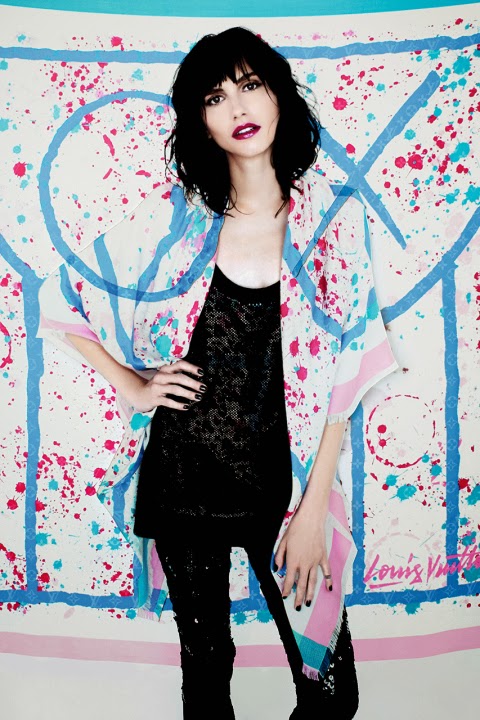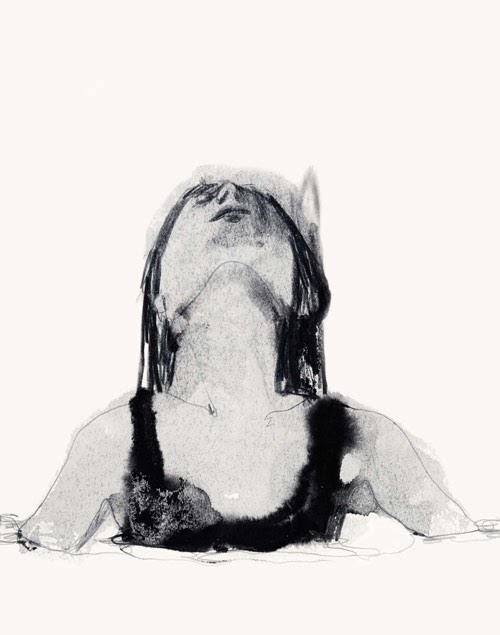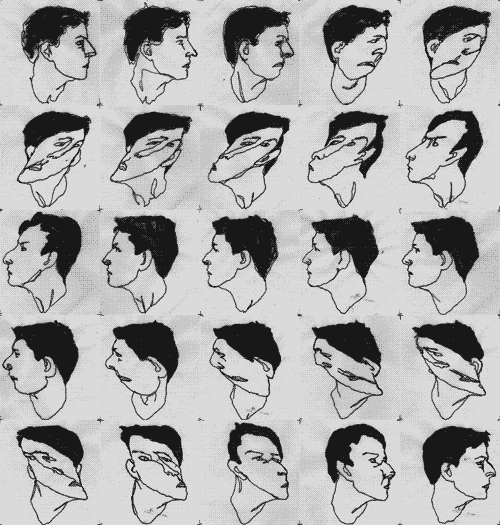Friday, January 31, 2014
“Jean-Michel Basquiat: Reclining Nude” is on view at The Suzanne Geiss Company, New York City, through February 22nd, 2014 By Traver Dodorye
Few had a closer look at the art-run social milieu of 1980s New York City than Paige Powell, then-girlfriend of Jean-Michel Basquiat and closest confidant of cultural impresarioAndy Warhol. And with her Canon camera, she caught it all. Three decades later, Powell begins unspooling a comprehensive archive (save for cameras lost in the backseat of taxis and confiscated from after hours clubs) that intimately captures the lives of an underground era to which she was doyenne; and her first offering is nude, black-and-white candids of her ex-lover, Basquiat.
It’s a bold place to start, with a private tableau of one of the most sought after artists in the world, but Powell’s pictures aren’t about Basquiat’s state of undress; they’re about Basquiat. Taken five years before his death in ’88, they show a sensitivity of the artist from a time he didn’t live to retell—but willed by friends, Powell could. “I woke up one morning and thought, ‘Wow, what would Jean-Michel think of this?’ and I thought, ‘Oh my god, he would love it,’” she said. “And then I thought, ‘Well, what would Andy Warhol think?’—Oh god, he’d be so jealous.”
At New York City’s Suzanne Geiss Company, the portraits now hang in massive scale, and for the next month, the SoHo gallery lets us slip into an evening at Powell’s Upper West Side apartment—Basquiat lounging in the buff. “I wanted to make it feel like you were walking into the room with him, to have that immediacy and the intimacy of being in the room with Jean-Michel,” she said. And they do. But a generous Powell gives us even more: the backstory. “It was one moment in the relationship,” she said, but it was also a snapshot of the way Basquiat worked. His artworks from the ’80s are widely viewed as his most coveted—and these photographs let us witness how he made them.
At the time, Powell was associate publisher for Warhol’sInterview Magazine and moonlighting as an impromptu art dealer, showing and selling artists’ work out of the apartment where she was living—Basquiat, A-One, and Rammellzeeincluded—but it was her boyfriend’s drawings that covered her walls. He had brought his paintings and supplies to her 81st street apartment and filled it with his inspirations. “He’d stay up all night drawing,” Powell said. On this particular night, after a typical day of walking down Columbus Avenue shopping for records (“he’d buy armfuls of them”) Powell and Basquiat went to dinner and a movie and came back to her apartment where, not inconceivably, he’d chosen to undress. “Sometimes he would just take his clothes off,” she said. “Sometimes he would paint in brand new Comme des Garçons suits. He wore whatever he felt like wearing.” But no matter, Powell was forever shooting; and Basquiat, tirelessly painting.
“Reclining Nude,” as Powell’s title suggests, catches Basquiat at ease, reposing on a futon, listening to the records he’d bought that day and watching—dare she reveal it—cartoons. “I remember him saying to me, ‘Now Paige, remember: you can’t tell anyone my secret, that I get my ideas from watching cartoons.’” And for 25 years, she never told. Less confessional, though, are his other influences pictured, like the repertoire of books he’d open up and leave strewn across the floor. “He looked at a lot of Picasso and Cy Twombly, and was obsessed with Andy,” she said. “He’d get Hi-Fi stereo books, electrician books, and anatomy books from second-hand stores.” And though they’re not all pictured, there are enough in frame to prove her point.
Most revealing of all, Powell’s pictures show a sensitive side of Basquiat—of the 22-year old who had once asked Warhol’s permission to marry her (“As long as she keeps working atInterview, it’s okay,” Warhol had replied), and who, in his greatest form, had showed up at her door in a suit, with a tray of dripping ice cream cones. “He had gone to this ice cream store nearby, and filled a big tray with cones and all different kinds of ice creams, layered on top of each other, some with two scoops, some with three. By the time he got to my house—it was warm out—they had all melted down and were dripping off his hands onto his suit. I said, ‘this is beautiful but why did you bring so many?’ and he goes, ‘Because I wanted you to have your pick.’”
It’s no wonder, then, when Powell’s close friend Thomas Lauderdale discovered the contact sheets of these rare shots of Basquiat—at the time, astray from their negatives in daunting heaps of boxes—that he was certain Basquiat was where she should begin. Never mind her shots of Basquiat in the back of a limousine, watching James Bond, or a videotape of Keith Haring, painting a huge, papier maché elephant; both will have their day in time (and most likely, she says, spliced together.) From her home in Portland, where Powell is a photographer, curator, and animal rights activist, light-years away from the day she first arrived in NYC (vying for a job at Interview or with Woody Allen and granted both), enough time has passed to debut her archives with an intimate, thoughtful perspective into the life of her once-beau—and a side of Basquiat we’d otherwise have never known.
“Jean-Michel Basquiat: Reclining Nude” is on view at The Suzanne Geiss Company, New York City, through February 22nd, 2014.
Wednesday, January 29, 2014
Street Art takeOver
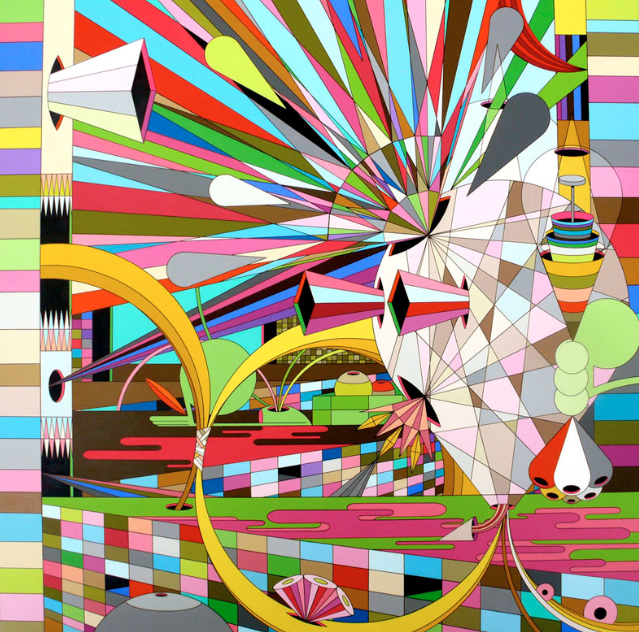
By Randy Gladman
The website of the Southeastern Centre for Contemporary Art (SECCA) in Winston-Salem, North Carolina, recently posted a six-minute long time-lapse video of the production of an onsite mural painted by the artist Dalek (James Marshall) and his team of assistants. Created for the exhibition North Carolina New Contemporary, Dalek’s vibrant and kaleidoscopic abstraction of video-game aesthetics slowly assembles in front of the camera lens to the beat of a jazzy soundtrack. As I watched the video this past Saturday night, with a touch of cabin-fever inspired by the Hoth-like Toronto winter outside my window, I thought about how great it is to see a deserving and brilliant Street Artist given time, space and resources by a museum, particularly one as charmingly off the beaten path as the SECCA. Here is more evidence, I realized, of the ongoing ascendance of the most important art movement of the new century.
The term “street art” has shifted in a positive direction over the past 10 years. This metamorphosis has been even more pronounced since the practical adoption of Shepard Fairey’s “Hope” posters by Barack Obama’s presidential campaign in 2008. Street art was once considered a societal infection that plagued beleaguered urban densities, but the mature examples of this visual art form have now invaded even the most holy contemporary museums and been championed by a new generation of collectors, curators and cultural commentators. Though many fine art periodicals have willfully or ignorantly displayed disappointing obliviousness to the importance of these young practitioners, an army of well-funded crossover magazines and websites have elevated these artists among audiences far hipper, more connected and massive than those the traditional art media enterprises can muster or interest. Possibly the current best documentary Oscar nomination of Banksy’s mind-twisting film Exit Through The Gift Shop will shake and awaken the upper levels of the art establishment from its slumber.
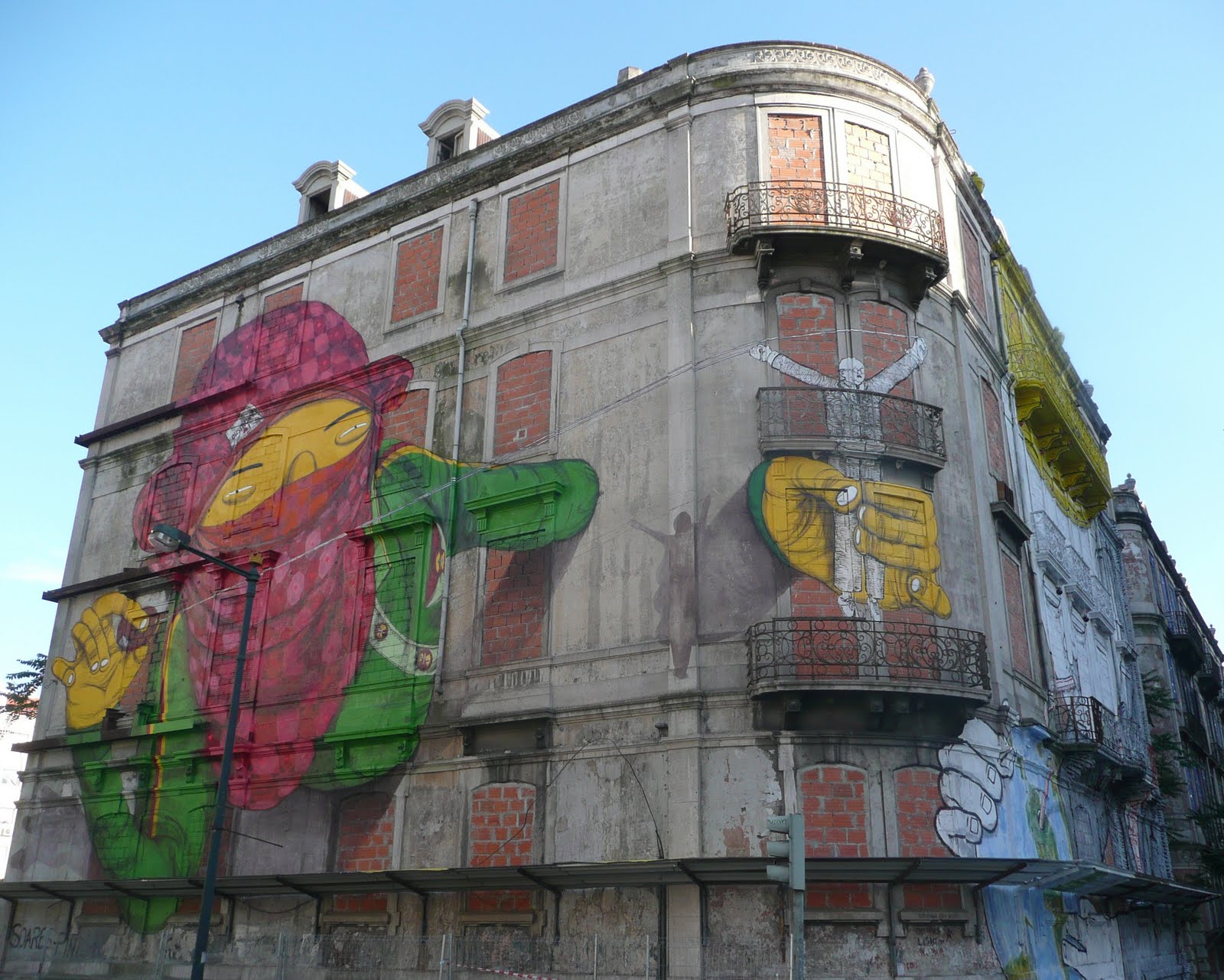
The pieces created by street artists like Banksy, Barry McGee (Twist), and Os Gemeos (twins Otavio and Gustavo Pandolfo), are not yet viewed as “blue chip”. This is because their collectors and strongest admirers are still exploring the outer reaches of their youth; the oldest of these supporters are generally still developing their successful professional careers and nurturing financial resources that are not quite ready to be deployed toward the serious aid of high culture. Just like all those before it, however, this generation, my generation, is on the march, driving tastes, and growing into influence. We are far more interested in the contemporary pop street artists whose points of references we share than in the current retinue of darlings promoted by the mega-galleries whose works are surely brilliant but not popularly compelling. By the end of this decade, our financial might will come to prominence, it will be our turn. When it comes to the visual arts, it will be street art in its gallery form that we will elevate. We have already begun to do so, but this effort is still nascent.
As the great street artists and their artworks enter public consciousness, it is imperative to note the direction of the movement. The museums and the market have come to street art, not the other way around. There is no sell-out here, no compromise. Though random, monikered, cowardly critics may claim otherwise and hurl accusations from the shadows of the blogosphere, these street artists have not “gone mainstream”. At least not the better ones. Instead, mainstream went Main Street. Just as cool new vocabularies and manners of speech ferment and ripen in rough urban quarters before they are appropriated and widely adopted by the middle-classes, the works of Shepard Fairey, C215 (Christian Guémy), Stephen Powers (ESPO), and a whole loosely affiliated brotherhood of artists are being soaked up from above. Any metamorphoses that occur do so within the DNA of the consuming masses rather than within the bloodlines of the creators. Even a cursory look at the current quality of daily street art interventions on the streets of Brazil, New York, Paris, London or Tokyo demands an acknowledgment that this folk-art form has never been as good as it is right now. When the street art photographer JR recently won the 2011 TED Prize without having to compromise anything about the way he produces or displays his work, any lingering relevance of the clumsy accusations of selling out evaporated alongside whatever doubt still existed regarding the cultural imprint and crossover appeal of these artists.
And is crossover appeal not eventually the truest measure of superior artistic achievement? While cerebral flexibility and opaque moral questioning are the hallmark of many intellectual artistic masterpieces that deserve museum protection and historical relevance, our most widely-valued artworks are those produced by the popularly agreed-upon pantheon of artistic geniuses. Pablo Picasso and Vincent van Gogh will always be cherished above Matthew Barney and Paul McCarthy because they offer a way in for everyone, not just a minority with a fetish for obscure analytical discourse. From Jacques-Louis David through Andy Warhol, the great artists of any era are those who reflect culture with a popular mirror large enough for everyone to peer into, not just a self-selected slice of the population.

Because the medium used by street artists is the most public of all, namely our transportation infrastructure (streets, trains, tunnels, and bridges), their work is suckled from the very beginning by the impulsive need to transmit meaning to anybody and everybody, not just somebody. This is their greatest strength. This form of art is no longer relegated to the kids’ table; it is finally starting to take its well-deserved seat with the adults of high culture.
Sunday, January 26, 2014
When art meets fashion by Traver Dodorye
Traver Dodorye is a designer and miami based abstract artist and he has been hand painting on apparel since 2007. Traver has always vision the fashion industry collabing with art and he says 2014 will be the year it goes viral. Lebron james wears Balenciaga paint splatter sneakers, Kanye west gets Fiance Kim Kardashian customer Hermes bag hand painted by artist George Condo.
Thursday, January 23, 2014
Subscribe to:
Posts (Atom)

































